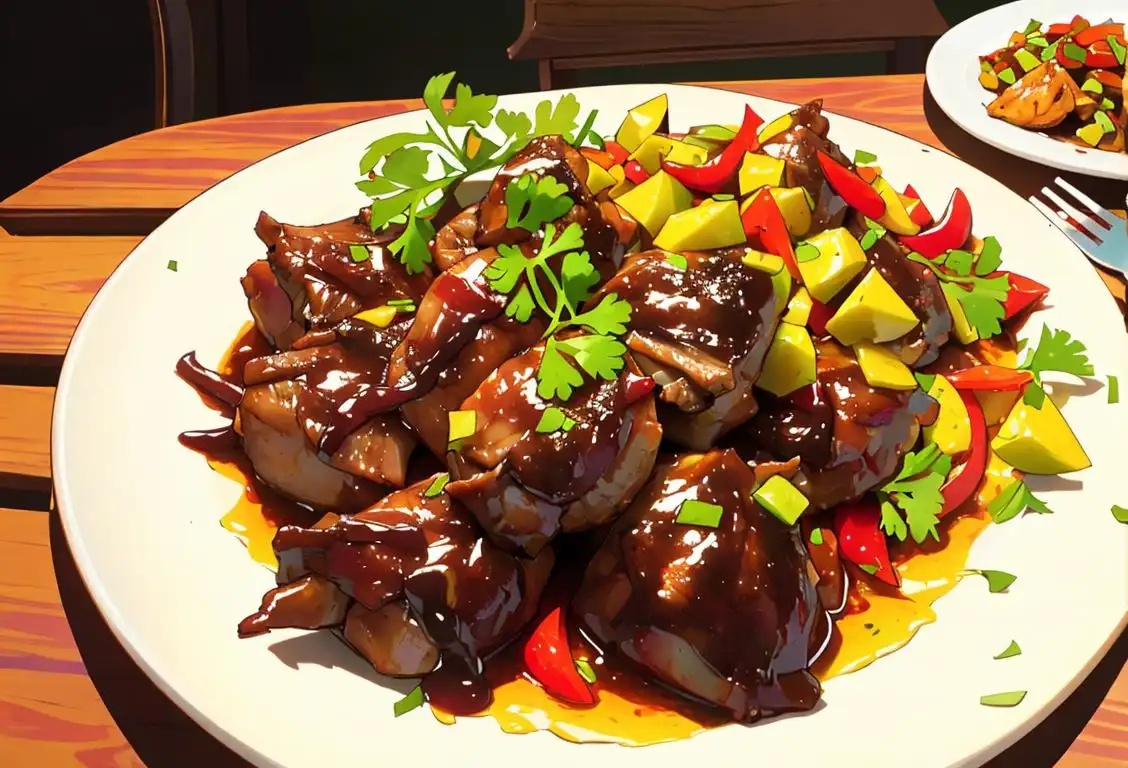National Oxtail Or Jerk Chicken Day

Welcome to the tasty world of National Oxtail or Jerk Chicken Day! Prepare your taste buds for a mouthwatering adventure as we explore the rich flavors and culinary traditions surrounding these delectable dishes. Get ready to savor every bite and discover the fascinating history behind these beloved meals.
When is Oxtail Or Jerk Chicken Day?
It's national oxtail or jerk chicken day on the 8th March.
The Juicy History of Oxtail and Jerk Chicken
Oxtail, the tail of a cow or steer, might not sound like the most appetizing cut of meat, but oh boy, once you taste it, you'll be hooked! This flavorful meat is often braised or slow-cooked to achieve melt-in-your-mouth tenderness. It's no wonder oxtail has become a culinary sensation around the world.
As for jerk chicken, it's a true Jamaican classic. The dish gets its name from the unique way it's prepared. Jerking involves marinating the chicken in a mixture of spices, including allspice, scotch bonnet peppers, thyme, and garlic. The marinated chicken is then cooked over a smoky grill, resulting in a deliciously charred and aromatic dish.
Internet Origins
National Oxtail or Jerk Chicken Day burst onto the internet scene on March 8, 2016. It quickly gained popularity among foodies and fans of Caribbean cuisine. Social media platforms were abuzz with mouthwatering photos and recipes, making it impossible to resist celebrating these sumptuous dishes.
History behind the term 'Oxtail Or Jerk Chicken'
1663
Introduction of the term 'oxtail'
The term 'oxtail' first appeared in the English language in 1663. It refers to the tail of an ox, which was commonly used as a meat ingredient in various dishes. Oxtail became popular due to its rich and flavorful taste, especially when slow-cooked. Despite its name, oxtail can be sourced from different cattle breeds and is not limited to oxen.
1600s
The Arrival of Oxtail
Oxtail, also known as the tail of a cow, has a long history in the culinary world. It was commonly consumed in Europe as early as the 1600s, where it was valued for its rich flavor and gelatinous texture. Oxtail soup became a popular dish, especially among the working class in countries like England and France.
1662
Origins of Oxtail
Oxtail, a traditional dish made from the tail of an ox, has its origins dating back to the 17th century. In 1662, a cookbook titled 'The Accomplisht Cook' by Robert May was published, featuring a recipe for 'Ox Heels Stewed.' The dish was prepared by stewing the oxtail with various spices and vegetables, resulting in a rich and flavorful delicacy.
17th century
Oxtail stew emerges as a culinary tradition
Oxtail stew is believed to have originated in the 17th century in Europe. The tail of an ox was considered a less desirable cut of meat and was often given to servants or sold at a lower price. However, creative cooks discovered that slow-cooking the oxtail with aromatic herbs, vegetables, and spices resulted in a rich and flavorful stew. This hearty dish soon became popular among the working class and eventually spread to other parts of the world.
17th century
Origins of oxtail
Oxtail is a term that originated in the 17th century and refers to the tail of an ox. It was a popular ingredient in European cuisine, particularly in Britain and France. Oxtail was often used in stews and soups, as its long and bony structure provided a rich and hearty flavor to the dishes. Despite its name, oxtail is not exclusively made from oxen, but can come from other cattle breeds as well.
17th century
Oxtail Soup
Oxtail soup emerged in the 17th century as a popular dish in British cuisine. It was initially enjoyed by the wealthy due to the expensive nature of oxtails. The gelatinous meat of the oxtail was slow-cooked and often paired with vegetables, such as carrots and potatoes, to create a hearty and flavorful soup. Oxtail soup became a symbol of indulgence and was served at luxurious banquets and grand dinners.
18th century
Origins of oxtail stew
During the 18th century, oxtail stew began to gain popularity as a hearty and comforting dish. The use of oxtail in cooking traces back to the tradition of using all parts of the animal for food. Oxtail, consisting of the tail of an ox, was often considered a cheaper cut of meat and was therefore utilized in stews to stretch expensive ingredients like vegetables and spices. The slow cooking process allowed the tough meat to become tender and flavorful, making it a delicious dish in various cuisines.
17th century
Early Use of Ox-tail in Cooking
In the 17th century, oxtail became a popular ingredient in European cuisine. The use of oxtail in cooking originated from the practice of utilizing all parts of the animal, making it an economical choice. The meaty and flavorful nature of oxtail made it ideal for creating hearty stews and soups.
1838
Jerk Seasoning Emerges
The term 'jerk' refers to a cooking technique commonly associated with Jamaican cuisine. It involves marinating meat in a blend of spices known as jerk seasoning and grilling it over a wood fire. The origins of jerk seasoning can be traced back to the early 19th century when African slaves in Jamaica utilized the technique to add flavor and preserve meat.
18th century
Jerk seasoning develops in Jamaica
During the 18th century, Jamaica was a major hub for the slave trade, with people from different cultures brought together on the island. It was during this time that jerk seasoning was born. The technique of marinating meat in a combination of herbs and spices, including scotch bonnet peppers, allspice, and thyme, originated from Maroons, a group of escaped slaves who sought refuge in the mountainous regions of Jamaica. They developed this unique seasoning method to preserve and flavor meats.
17th century
Introduction of jerk cooking
Jerk cooking, on the other hand, is a style of cooking that originated in Jamaica during the 17th century. It involves marinating meat in a unique blend of spices, such as allspice, cloves, thyme, and cinnamon, before slow-cooking it over a wood fire. The term 'jerk' is said to come from the Spanish word 'charqui,' which means dried meat. This method of cooking was developed by African slaves who used the spices and cooking techniques from their homeland, combining them with local ingredients to create delicious and flavorful dishes.
19th century
Jerk Cooking Technique Emerges in Jamaica
During the 19th century in Jamaica, African slaves developed a unique cooking technique called 'jerk.' Jerk involves marinating meat in a spicy mixture primarily made with scotch bonnet peppers, allspice berries, and other herbs and spices. The meat is then slow-cooked over a fire or grill, giving it a distinct smoky and spicy flavor. This technique was originally used with pork, but was later adapted with other meats, including chicken.
18th century
Jerk Spice
Meanwhile, in the 18th century, the roots of jerk spice were taking shape in Jamaica. The term 'jerk' likely derived from the Spanish word 'charqui' meaning dried meat. Jamaican Maroons, descendants of escaped African slaves, developed the technique of seasoning and slow cooking meat over pimento wood or charcoal fires. This method preserved the meat while infusing it with a distinctive smoky and spicy flavor. The flavors of jerk spice soon became synonymous with Jamaican cuisine.
17th century
Jamaican origins of jerk chicken
Jerk chicken, a delicious Jamaican dish, has its roots in the 17th century. The technique of marinating meat with a spicy combination of herbs and spices and then cooking it slowly over a fire originated with the Maroons, African slaves who escaped to the mountains of Jamaica. The Maroons introduced the concept of jerk seasoning to the island, and it quickly became a staple in Jamaican cuisine.
1670s
The Emergence of Jerk Cooking
Jerk cooking originated in Jamaica during the late 17th century. It was a technique used by African slaves who escaped into the mountains and forests. They would preserve and cook their meat by marinating it in a combination of spices, including allspice and scotch bonnet peppers. The meat, often chicken or pork, was slow-cooked over a fire, which infused it with a unique smoky flavor.
17th century
Introduction of jerk cooking
In the 17th century, African slaves brought to Jamaica by British colonizers introduced a cooking technique known as jerk. Jerk cooking involves marinating meat, especially chicken, with a spicy blend of herbs and spices. The blend typically includes ingredients such as scotch bonnet peppers, allspice, thyme, garlic, and ginger. The meat is then slow-cooked over pimento wood, which imparts a unique smoky flavor to the dish. Over time, jerk chicken became an integral part of Jamaican cuisine and a symbol of the island's vibrant food culture.
1960s
Jerk Chicken Gains Popularity
In the 1960s, jerk chicken gained significant popularity in Jamaica and began to spread internationally. The flavorful combination of jerk seasoning, typically featuring spices like allspice, thyme, scotch bonnet peppers, and garlic, became synonymous with Jamaican cuisine. Jerk chicken is often served with rice, peas, and a variety of side dishes, making it a beloved dish representing the vibrant flavors of the Caribbean.
20th century
Jerk Chicken Gains Popularity
In the 20th century, jerk chicken started to gain popularity worldwide, becoming one of the most famous dishes in Jamaican cuisine. The combination of the jerk technique with the succulent meat of chicken created a delicious and spicy dish loved by many. The flavors of scotch bonnet peppers, allspice, thyme, and other spices make jerk chicken a tantalizing culinary experience.
20th century
Jerk Chicken
In the 20th century, the fusion of British and Jamaican culinary traditions gave rise to the popular dish known as jerk chicken. Inspired by the rich flavors of jerk spice, Jamaican cooks began marinating chicken in a special blend of spices, including allspice, scallions, thyme, ginger, and peppers. The marinated chicken was then grilled over an open flame, creating a mouthwatering dish with a perfect balance of heat and smokiness. Jerk chicken quickly became a staple in Jamaican cuisine and gained international recognition for its bold and unique flavor.
18th century
Incorporating oxtail into Jamaican cuisine
In the 18th century, Jamaican cuisine began to incorporate oxtail as an ingredient in traditional dishes. The rich and gelatinous nature of oxtail made it an excellent addition to Jamaican stews and soups, adding depth and complexity to the flavors. Oxtail became a staple ingredient in Jamaican cuisine, with variations of oxtail stew and oxtail soup becoming popular dishes among the locals.
Early 20th century
Jerk chicken gains popularity in Jamaica
In the early 20th century, jerk chicken started gaining popularity among the locals in Jamaica. Street vendors and restaurants began selling this flavorful and spicy dish, attracting both locals and visitors. The tender chicken is marinated in jerk seasoning, usually overnight, and then cooked on a grill or over pimento wood, which adds a distinctive smoky flavor. The aroma and taste of jerk chicken soon became synonymous with Jamaican cuisine.
1700s
The Fusion of Oxtail and Jamaican Cuisine
As the years went by, Jamaican cuisine evolved and embraced various influences. In the 18th century, the combination of traditional British oxtail soup and the vibrant flavors of Jamaican jerk seasoning gave birth to a beloved dish: oxtail stew. The flavorful jerk spices added an extra kick to the rich and tender oxtail, creating a dish that would become a staple in Jamaican households.
Present day
Oxtail and jerk chicken international delights
Today, oxtail stew and jerk chicken have become international culinary delights, loved and enjoyed by people around the globe. Oxtail is now appreciated for its rich and succulent meat, often braised or slow-cooked to tender perfection. Restaurants worldwide offer oxtail dishes with their unique variations of flavors and ingredients. On the other hand, jerk chicken has become a symbol of Jamaican culture and is served in countless Jamaican restaurants and food stalls globally. The popularity of both oxtail stew and jerk chicken continues to grow as they delight taste buds and bring a touch of cultural heritage to the table.
20th Century
Jerk Chicken's Rise to Prominence
Jerk chicken gained widespread popularity in the 20th century, thanks to Jamaica's increasing global influence and the rise of tourism on the island. Traditional jerk shacks and restaurants started serving jerk chicken alongside other jerk dishes. The distinct flavors and cooking techniques of jerk chicken quickly captured the attention of international food enthusiasts, making it one of the most recognizable and beloved Jamaican dishes worldwide.
20th century
The birth of oxtail and jerk chicken
As Jamaican cuisine gained recognition and popularity worldwide, the combination of oxtail and jerk cooking became a celebrated culinary delight. Oxtail, with its tender meat and unique flavor, was cooked using the traditional jerk method, infusing it with the signature Jamaican spices. This fusion gave rise to the mouthwatering dish known as 'oxtail and jerk chicken,' where both meats are marinated and cooked together, creating a tantalizing blend of flavors.
21st century
Jerk Chicken Goes Global
In the 21st century, jerk chicken has become widely recognized and appreciated around the world. It has made its way onto menus in various countries and is often enjoyed at street food festivals and Jamaican restaurants. The unique blend of spicy, smoky, and savory flavors continue to captivate taste buds and keep jerk chicken in high demand. People everywhere are discovering and relishing in the delights of this flavorful dish.
Did you know?
Did you know that oxtail is known for its gelatinous richness and depth of flavor? It's like a beefy party in your mouth!Tagged
food fun tagsFirst identified
8th March 2016Most mentioned on
8th March 2016Total mentions
4Other days
Oxtail Or Jerk Chicken Day
Sweet Tea Day
Vodka Day
Iced Tea Day
Pumpkin Day
Guac Day
Medal Of Honor Day
Foundation Day
Cheese Pizza Day
Bacon Day








